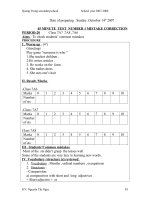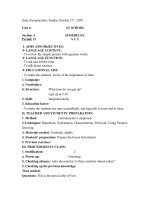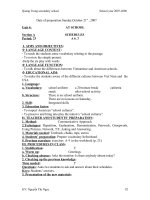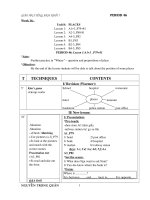unit 4- tiếng Anh 7- tiết 21
Bạn đang xem bản rút gọn của tài liệu. Xem và tải ngay bản đầy đủ của tài liệu tại đây (75.33 KB, 3 trang )
Date of preparation: Sunday October 21
st
, 2007
Unit 4: AT SCHOOL
Section A SCHEDULES
Period: 21 A 1, 2
I. AIMS AND OBJECTIVES:
LANGUAGE CONTENT:
- To review the simple present with question words.
LANGUAGE FUNCTION:
- To ask and tell the time.
- To talk about routines.
EDUCATIONAL AIM:
- To make the students’ aware of the importance of time
1. Language:
a. Vocabulary:
b. Structure: What time do you get up?
I get up at 5.30.
2. Skill: Integrated skills
3. Education factor:
- To make the students use time scientifically and logically to learn and to relax.
II. TEACHER AND STUDENTS’ PREPARATION:
1. Method: Communicative Approach.
2.Techniques: Repetition, Explanation, Demonstration, Pairwork, Using Pictures,
Drawing.
3. Materials needed: Textbook, chalks.
4. Students’ preparation: Prepare the lesson beforehand.
5. Previous exercises:
III. PROCEDURES IN CLASS:
1. Stabilization: 2’
a. Warm up: Greetings
b. Checking absence: Asks the monitor: Is there anybody absent today?
2. Checking up the previous knowledge:
Time needed:
Questions: This is the period after 45’test
3. Presentation of the new materials:
TIME TEACHER’S ACTIVITIES
STUDENTS’
ACTIVITIES
THE CONTENT OF
THE LESSON
7’
7’
I. WARM-UP:
1. Gives the students instructions and
has them draw the picture.
- Draw a circle.
- Put the number 12 at the top of the
circle.
- Put the number 6 opposite number 12.
- On the right side in the middle put the
number 3.
- Opposite number 3 put number 9.
- Between 9 and 12 put 10 and 11.
- Between 6 and 9 put numbers 7 and 8.
- Between 12 and 3 put numbers 1 and
3.
- Between the numbers 3 and 6 put the
numbers 4 and 5.
- What have you drawn?
- What do we use it for?
2. Introduces and tells the aims of the
lesson:
- Says: Today you are going to learn
Unit 4: At School, Section A, Part 1
and 2. In this period you will review
asking and telling the time and practice
talking about routines.
II. PRE-PRACTICE:
1. Reviews talking about the time:
- Has the students listen and repeat A1.
- Reminds the students that there are
two ways to say the same time.
+ It’s four fifteen. = It’s a quarter past
four.
+ It’s five twenty-five. = It’s twenty-
five past four.
+ It’s eight thirty. = It’s half past eight.
+ It’s nine forty. = It’s twenty to ten.
+ It’s one forty-five. = It’s a quarter to
- Listen carefully to
the teacher and
draw.
- Listen to the
teacher carefully.
- Listen and repeat.
- Listen and take
notes.
Unit 4: AT
SCHOOL.
Section A:
SCHEDULES
Period: 21 A1, 2
I. Content:
1. Listen and repeat.
- It’s seven o’clock.
- It’s four fifteen.
It’s a quarter past
four.
- It’s five twenty-
five.
It’s twenty-five
past five.
2. Now practice
saying the time with
a partner.
What time is it?
It’s seven o’clock.
3. Answer about
you.
II. Remember:
What time do you
get up?
I get up at ...
III. Homework:
- Learn the lesson
well.
- Do exercises A 1,
2 in the workbook
(p. 21, 22)
14’
5’
5’
two.
III. CONTROLLED - PRACTICE:
1. Has the students pratice saying the
time with a partner.
- Invites some good students to ask and
answer about the time.
- Checks some pairs.
2. Answer about you:
- Has the students ask and answer the
questions in pairs.
- Goes round to help the students.
- Checks some pairs, corrects their
mistakes.
IV. FREE - PRACTICE:
- Divides class into pairs, has them talk
about their routines.
- Invites some students to go to the
front and talk about their routines.
V. CONSOLIDATION:
- Asks questions relating the main
points of the lesson.
- Practice saying the
time with a partner.
- Some ask and
answer.
- Ask and answer
questions in pairs.
- Answer.
- Work in pairs, talk
about their routines.
- Some go to the
front and talk about
their routines.
- Answer.
4. Homework: 5’
- Learn the lesson well.
- Do exercises A 1, 2 in the workbook (p. 21, 22).
5. Preparation for the next lesson:
Prepare Unit 4, section A, part 3, 4,5(interesting,important , difficult ,fun )
6. Self – evaluation:
.......................................................................................................................................
.........................................................................................................................









